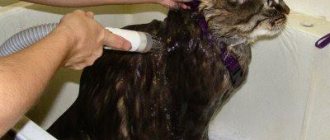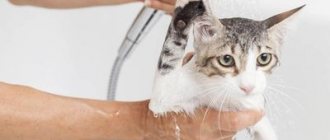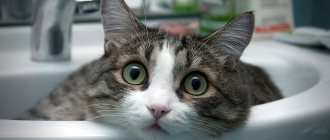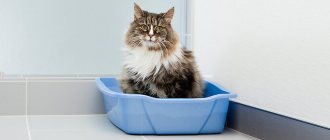Kittens really don't like water treatments. For them, water is associated with something scary and unpleasant. But no one canceled washing, because this is the key to cleanliness and health. It is better to accustom your kitten to water from an early age. So, he will get used to the procedure and love bathing. But in order for this process to take place in peace and comfort, you should take care of the bathing rules in advance. So how to wash a kitten correctly?
The advisability of bathing
Many people do not understand why bathe a kitten if nature has endowed it with a rough tongue with which it washes itself. Of course, a rough tongue helps kittens take care of their fur and remove small particles of dirt from their bodies. Kittens can spend several hours licking themselves. And this is justified. After all, wild cats carefully lick themselves before the hunt to obscure their own scent. So, hunting brings results.
Why are kittens afraid of water? It is known that cats are heat-loving animals. But when their fur coat, which protects them from the cold, gets wet, the kittens lose their ability to retain heat and freeze. Pets that are always warm and have weakened immune systems begin to get sick. Also, an inappropriate choice of shampoo will result in allergies, dry skin, hair loss and brittleness for the kitten.
Some especially love to swim and get into the water themselves, but this happens in rare families.
Then in what cases should you bathe a kitten?
- The fur was covered with a greasy coating.
- Accumulations of dirt and stickiness are visible on the skin.
- Wool has an unpleasant odor.
- Fleas.
- If the kitten is very dirty and licking becomes dangerous.
- If a purebred kitten has no fur.
Why wash?
Cat breeders with extensive experience clearly believe that pets need to be bathed in the following cases:
- in the presence of parasites, fleas, ticks in the coat;
- if serious contamination appears;
- as a means of prevention;
- during molting.
During coat changes, water treatments are required.
Cats shed periodically. When an animal licks its own fur, dirt and germs enter the body with saliva. During the molting period, the amount of fur increases and it is difficult for the pet to cope with its natural shedding. Thus, the digestive system of the pet is the first to suffer. To avoid this problem, it is recommended to combine the molting period with bathing the cat.
Contraindications to bath procedures
There are also contraindications in which bathing a kitten is strictly prohibited. In such cases, it is better to wipe the coat from above with a damp cloth.
- Quarantine and vaccination. If your kitten is undergoing a two-week quarantine or has already been vaccinated, do not bathe him under any circumstances until this period is over.
- Lichen. A dangerous disease that concentrates in one place, and if you completely bathe the kitten, it can spread throughout the entire skin.
- Illness and operations. If your little pet is sick, no matter what disease, it is better to refrain from bathing until he has fully recovered.
- Stress. During times of stress, it is better not to expose the kitten to even greater stress, otherwise the small animal’s nervous system will definitely not be able to withstand it.
Have pity on your pet and do not expose it to even greater danger.
Is it necessary to do this at all?
Some owners argue as follows: since cats themselves are very clean, it is not at all necessary to subject them to the enormous stress that is bathing at home. This opinion is wrong. How to properly bathe a cat can only be learned by approaching this issue with all responsibility. It must be said that it is necessary to wash cats for the reason that dust and dirt gradually accumulate on their fur, which cannot be cleaned out with a rough tongue. Cats are real clean people, and therefore they will lick themselves endlessly, trying at all costs to get rid of any dirt. This excessive littering can lead to a large accumulation of cat hair in the stomach and cause a number of diseases.
You should wash your cat no more than once or twice every six months. Of course, a lot will depend on what kind of coat she has. If a cat wears a luxurious fur coat, then he will have to be bathed more often. Grooming is especially necessary for show animals before important events. In other cases, you need to wash your purr as needed.
At what age can you bathe a kitten?
Veterinarians do not recommend bathing a kitten until 3 months old, since during this period their skin glands are just forming. If the protective secretions are washed off from the skin, the kitten may develop dermatitis. In the first month, the kitten is calmly licked by its mother. Subsequently, he learns to do it himself and this will be enough for him.
Already after three months of age, if the kitten knows its owners and trusts them, you can bathe the animal for the first time. You don’t have to put this procedure aside. It is better for a kitten to get used to water at an early age.
If a kitty or cat has gotten very dirty, but they have not yet learned to lick themselves, you can wipe the dirty areas with a damp cloth.
Begin washing with awareness and confidence so that your cat feels your love for him.
Prevention
To prevent your straight-eared cat from being overcome by diseases, including infectious ones, it is important to get vaccinations on time, feed her properly and monitor her appearance and behavior. Many diseases can be prevented by providing proper nutrition, proper care and attention to the animal.
From the list of everything that is necessary to provide proper care, it is first of all important for the cat owner to ensure that the necessary vaccinations are completed on time. This is especially important if your Scottish Highlander has the opportunity to roam freely and interact with other animals.
Thus, mandatory rabies vaccinations are carried out as early as 3 months. Having a passport indicating your vaccinations will allow you to obtain the necessary certificates and travel by plane or train absolutely legally.
It is necessary not only to know the symptoms that may indicate that your Straight is sick, but to be regularly examined by a veterinarian. The specialist will determine the cat’s condition, and in case of illness, he will advise what and how to treat it, what to feed and how to care for it.
Bathing frequency
But you shouldn’t immediately run out and wash your pet almost every day. Such a frequent procedure will not benefit the kitten. With frequent bathing, the coat deteriorates and the skin becomes dry.
Domestic kittens should be washed 2-4 times a year. For example, you can wash your pet once every quarter (3 months).
If your kitten goes for walks outside, or you go out with him periodically, then after each walk you should definitely wash his paws. Well, general bath procedures should be carried out 6-10 times a year.
For hairless kittens, bath procedures are considered almost the basis of everything. Since their skin is not protected by fur, it secretes a secretion that quickly begins to spread an unpleasant odor, and such kittens get dirty faster. Therefore, such kittens are washed approximately once a month.
Also, veterinarians recommend bathing a kitten once in winter and autumn, and twice in spring and summer.
Do not neglect the health of your pet; take washing with great responsibility. The main thing is not to go through this procedure frequently.
When not to wash your pet
Sometimes situations arise in which regular washing may be contraindicated for cats. Owners are beginning to wonder how to wash their cat without water and whether it is even possible - fortunately, it is possible.
Contraindications to regular washing include pregnancy (bathing can cause stress in the cat and, as a result, premature birth), the postoperative period, 2-3 weeks after the cat has been vaccinated.
Some illnesses are a contraindication to regular washing; you should consult your veterinarian on this issue. It is better to refuse bath procedures if the cat is constantly itching and has unhealed scabs on its skin.
There are several ways to wash a cat with and without water, without causing stress to the animal. They can be used to clean a dirty pet during pregnancy or illness.
How to prepare for washing
Before starting bath procedures, it is important to prepare in advance for such a serious event. The main thing when washing a kitten is not to scare it, so that it does not experience unpleasant sensations when it comes into contact with water.
General recommendations to follow include:
- Close the door tightly and avoid drafts.
- Trim your pet's nails and brush them beforehand.
- To begin, add water 10 cm from the bottom. Then add, but not above the shoulders.
- The water temperature should be between 35-40 degrees.
- Do not bathe your kitten immediately after eating. About 4 hours must pass before you can take bath procedures.
The main thing is that the fluffy does not participate in the preparatory process.
Most of all, kittens are afraid of the sound of water from a tap or shower. Therefore, it is not recommended to turn them on while your pet is near you.
Selection of hygiene products
There is a huge selection of pet wash products on the market. Such shampoos are distinguished both by skin type and consistency. But kittens need gentle products and they need products that are specifically designed for them. It is worth consciously approaching the choice of shampoo with which you will wash your kitten.
- Liquid shampoos will make your kitten's fur soft and fluffy. This product foams quickly, so only a small amount of shampoo is needed.
- Dry shampoos are not used with water, so the kitten must be dry. Shampoo is applied to the skin and combed off along with the dirt.
- Sprays are also used on dry skin.
- Special shampoos are aimed at combating problems and have the desired effect. Such shampoos fight parasites, and there are also medicinal ones for damaged kitten skin.
Never use the shampoos that we humans use to wash our hair. For animals, such products are very aggressive.
Inventory
Prepare in advance everything you will need when washing your kitten.
- Veterinarians do not recommend bathing kittens in the bathtub as it is too big for them. It is better to prepare a special bath for bathing children and a ladle.
- Towels and rags. You will need towels to dry the kitten after the bath, and place a rag on the bottom of the bath to make it more comfortable for the kitten to stand.
- Place shampoo, small washcloths, and toys next to the basin.
- To protect your head and ears, you can purchase special hats and earplugs.
- For calm incubation of all procedures, you can buy a special net for bathing for the kitten. This way he won’t run away and won’t scratch you.
With such a combat set, you will definitely be 100% ready to bathe your pet. Just don’t forget to call someone for help to be on the safe side. Washing your pet is much easier with two people.
There are special caps for washing kittens, nets and fastenings.
Toilet and tray training
Usually there are no problems with taming to the tray. In nature, cats bury their feces in the ground, so it is convenient for cats to do their business in a litter tray. Wood or cardboard is preferable as a filler - it does not generate dust and absorbs odors well.
Important! To accustom a kitten to the litter box, when the animal first appears at home, you can take it to the house and show it where to go to the toilet.
You can carefully dig your kitten's paw into the litter
If a cat suddenly begins to go to the toilet in the wrong place, you should not scold them. Perhaps the reason is severe stress or poor health. For example, a Scottish cat will never stoop to peeing in a dirty litter box. If the reasons for this behavior are not obvious, an animal psychologist or veterinarian will help to deal with the problem.
Bathing a kitten - how the procedure works
The most common bathing is done with liquid shampoo, so use that. How to bathe a kitten correctly and without harm:
- Place the kitten in a bath that is already filled with water at about 40 degrees. The kitten must reach the bottom and not drown. Grab the kitten by the scruff of the neck. So, he will not have the opportunity to flounder and scratch. Calm the baby, talk to him, praise him.
- First, wet his fur with a ladle. Do not wet your ears and head - it is better to avoid getting water in these places. You can take a shower instead of a ladle, but only if the kitten is not afraid of the stream that runs from there.
- Pour a small amount of shampoo onto your hand and rub between your palms. It is important that the foam has already formed on your palms, this makes it easier to apply it to the wool. Apply shampoo to the back, paws, tummy, and tail. Don't touch your head or ears.
- Take a washcloth designed specifically for your pet and gently soap your cat. Distribute the foam in all places. Pay special attention to the pads on the paws, genitals, armpits, chin, neck. A lot of dirt accumulates in these places, because they are difficult for the kitten to reach. Wash off dirt thoroughly.
- The most unpleasant thing is washing your hair, so we postponed this item to the very last. Using a washcloth, gently wet your head and ears.
Carefully! Water should not get into the eyes and ears, as the pet may experience inflammatory processes.
- Lather your hair, also carefully, massage lightly. You only need a little foam on your head.
- Now you can wash it off. Using a shower or a ladle, water the kitten from top to bottom, that is, from head to tail. There should be no foam left, all fur should be clean, otherwise the kitten may be poisoned by hygiene products when licking itself.
- Place the kitten in a warm, terry towel. Let him warm up a little in this towel. Take a second towel and blot all areas so that no water remains.
Step No. 4. Prepare towels and washing area
Before you catch the cat and take it to the bathroom, you need to prepare everything for this.
First, choose a location. Many people prefer to bathe cats in basins or sinks. In fact, this method is not suitable for everyone, because when the cat is already large enough and this basin or washbasin is only one tooth long, it costs nothing for her to break out and hide in an unknown direction. Therefore, by the way, it is better to close the bathroom. As a result, it turns out that the most reliable place for bathing is still the human bathroom. Of course, even a teenage cat can jump out of it, but in the process of jumping out and while you catch it, less water will splash around. And you can put a towel at the bottom of the bathtub, this will help the cat feel a little more confident.
Secondly, you should have a couple of towels for your cat that absorb moisture well. Don't skimp - highlight some. This is for later drying and wrapping the animal.
How to bathe correctly for the first time
It is important that after its first wash the kitten has only pleasant memories. Therefore, carry out your bath procedure in comfort and coziness. For kittens who are trying to wash their coat for the first time, you should follow all the rules described above. And also adhere to the following tips.
Cheer up your four-legged friend.
- Introduce the kitten to the bathtub or basin. Show him the tap, the water. Also bring his toys, perhaps he will be calmer with them.
- For the first time, use unscented shampoos.
- It is better to wash a kitten for the first time not alone, but with someone. So, another person will hold and pinch the ears while you wash the kitten.
- Gently soap the kitten with a sponge and rinse off the foam thoroughly.
- Wrap the kitten in a warm towel and sit with it for about 10 minutes. Later, take another dry towel and wrap it again. Place the kitten in a warm place: a bed or a house.
- After washing, treat your purr with something tasty to make him feel better.
Step #5. Choosing toys
Some cats find it helps when toys splash around with them in the bathtub. And in general, at the beginning of the bathing process, you can try to imagine everything as a game. Fill up some water in the bathtub and throw toys in there, then provoke the cat to jump after them. But it must be honestly noted that it is rare that toys can distract a cat from the unpleasant process of bathing. Nevertheless, try it - what if such a distracting maneuver suits your cat?
The authors of this video decided to interest their cat in toys.
Article continues after advertisement
If the kitten is against
It also happens that a kitten is categorically against any water. Perhaps the kitten has bad memories creeping in, or water for him is an association of something terrible. But in order to solve such a problem, you should show patience and love for your baby.
Before washing, play with the kitten. During the game he will relax a little and get tired. This way he won’t have the strength to fight water wars in the bathtub.
The main thing is not to feed the kitten before the bath procedure.
While you put the kitten in the water, distract him with toys. There is no need to throw the kitten into the water, do everything smoothly and continuously.
If you still fail to wash your kitten, the only solution is dry shampoo or spray. Or wipe the wool with a damp cloth or napkin. So, you will not expose the kitten to water, but simply clean it with dry shampoo.
Do not shout or scold under any circumstances. Talk calmly and kindly to the kitten, praise it, laugh quietly and play.
Relationship with the toilet
If you take a kitten from a breeder, then the baby, as a rule, already knows that there is a special place for the toilet. When he appears in the house, you should immediately show him the tray, and the smart animal will not cause you problems, leaving puddles in the wrong places
Pay attention to the toilet filler. It is better if at first it is the same as in the previous house
The Scots prefer silica gel, which they love to dig for, enjoying the rustling sounds. In addition, it perfectly eliminates all odors. You can also choose sawdust pellets, but they require more frequent replacement.
If the baby is not yet familiar with the cat litter box, you need to immediately start raising the kitten until he gets used to relieving himself in places convenient for him. You should immediately explain to your pet that there is a special corner for the toilet.
A place for the tray must be chosen that is easily accessible, but quite secluded. Many cats like to do their business without attracting too much attention to themselves. A bathroom, toilet, or closet is best suited for this purpose. Just remember to always leave the door slightly open. You can choose a corner in the corridor.
If you categorically refuse to use the tray, changing the filler or its location often helps.
Breed characteristics and bathing
There are additional bathing instructions for different breeds. There is also an individual approach to washing, because everyone’s character and genes are different.
- The Scots and British wash themselves very carefully. And they take care of their fur many times better than others. Therefore, such kittens can be washed twice a year.
- Long-haired Siberian and Persian kittens, as well as fold-eared ones, are washed six times a year. Before washing, you should comb the coat thoroughly.
- Since the fur of white kittens is subject to more contamination, they can be washed with shampoos that are aimed at whitening.
- Sphynxes and other hairless kittens are washed only with special shampoos designed for their breed. I don’t wash my hair, but wipe it with napkins. After washing, be sure to rub with baby cream, but so that the kitten does not lick it off.
- Burmese kittens should be wiped daily with a damp cloth and bathed only if they are very dirty. This is because this type of breed has very thin and short hair.
Before bathing your pet, you should learn more about the characteristics of your cat.
Scottish fold sleeping place
The sleeping place should be quiet and calm so that the kitten can fully rest.
Choose a mattress no wider than 10 centimeters, not too soft. It is acceptable to use a sheep's wool ski mat or a special bed for kittens as a sleeping place. You can also buy or make your own house for a kitten. Its frame is cut out of thick cardboard, which can be wrapped with padding polyester, cotton wool or other soft material, and covered with natural fabric, for example, chintz sewing scraps. In such a house, a fold-eared cat can comfortably sleep.
Scottish Fold kittens are peaceful, curious and people-oriented creatures. With the right approach to education and care, you will get a devoted, intelligent and ready to help you in everything four-legged friend.
Drying your pet
The moment has come when it's time to dry. The main thing is to immediately wrap the kitten in a towel after washing so that there is no risk of getting sick. There are two types of drying:
- Leave the kitten in a warm room for 12 hours so that all the fur dries on its own. The kitten will take care of drying itself and will begin to lick itself for a long time. After all, he has special scales on his tongue that remove excess moisture.
- Blow drying is possible if the kitten is not afraid of this scary sound. Blow-drying is also better for long-haired kittens, as their fur takes longer to dry than usual and they need a little help. The main thing is to comb the coat while drying. It is recommended to dry with warm air so as not to burn or freeze your pet.
The main thing is to avoid open windows and drafts. Do not let the kitten outside while drying. Kittens are very prone to infections if their coats are wet.
Why are cats afraid of water?
A cat’s reluctance to bathe and fear of water is only a manifestation of innate instincts, since these are not at all “waterfowl” animals. Although some of the felines love water procedures, in particular tigresses. The main reason for the dislike of water is the rapid wetness of the fur, drying out of the skin and noticeable discomfort.
Don’t think that simply tying up and bathing a cat will be easy. You will have to spend much more time accustoming the cat to water so that it is not afraid and allows itself to be washed of its own free will. To begin with, it is recommended to bring your pet into the bath several times, try to open the water, put it in an empty bath, and make sure there is good lighting. Also, do not forget that it is much easier to accustom a cat to bathing if it is not older than one year. In the case of adult animals, success may not be achieved at all.
Expert advice
Bathing is a simple process that requires patience. And if you approach this with all your heart, the procedure will be fun. Bathe the kitten correctly, without causing him any unpleasant sensations, then he will get used to it and will not be afraid of water.
In conclusion, experts recommend using a couple more tips.
- It is best to bathe a kitten during shedding. So, the excess hair will go away, and the kitten will not be able to swallow some of the hairs that contain harmful substances when licking.
- If the kitten has already gotten very dirty somewhere, for example, in oil, then before bathing you should lubricate this area with butter and blot it with a paper napkin.
- If your kitten has fleas, it is important to use a specialized shampoo. Therefore, first, start washing the kitten from the neck so that while washing the body, fleas do not run to the head.
Choose exceptionally soft and comfortable towels for your pet.
Popular shampoos for bathing cats: review
List:
- Shampoo Doctor . This product contains benzoyl peroxide, which exhibits antifungal, antiviral, and antibacterial properties. Thanks to this, it gets rid of dandruff and also prevents the occurrence of lichen in cats. Can be used for cats of any breed.
- Shampoo Elite . This option applies only to hairless cats, that is, hairless ones. The composition contains many herbal extracts: thyme and eucalyptus, which help regulate the secretion of sebum and also prevent dry skin. Forms a kind of film on the surface that protects the pet’s sensitive skin.
- Perfect coat. An excellent product that reduces hair loss. Best prevents the formation of tangles in your pet’s stomach. In addition, the shampoo is anti-allergenic and can be used for bathing pets who suffer from allergies.
- Jerob shampoo . This is a professional product that is mainly used to prepare pets for exhibitions. Helps improve the condition of the coat, making it fluffy, smooth and shiny. The cost of the shampoo is quite high, so if you have an ordinary pet that does not participate in exhibitions, there is no point in purchasing this shampoo.
- Rolf Club . This is a whole line of cat care products. The fact is that these shampoos may contain completely different components. The line consists of shampoos for long-haired breeds, short-haired ones, and also with medicinal effects. They help get rid of lichen, fleas, and various bacterial lesions. Prevents the formation of dandruff, as well as excessive drying of the cat's skin. Choose the type of shampoo depending on the cat's breed, as well as the specific problem.
- Biovax shampoo . Contains Lanolin, which prevents your pet's skin from drying out. That is, the hairs are covered with natural wax, which gives the coat shine and a healthy appearance. Almost all animals are not allergic to this product, because there are very few allergens in the composition.
Shampoo for cats
For bathing, it is best to purchase shampoos at a veterinary pharmacy or special pet stores. They have a special composition and do not dry out the cat’s skin at all.
Bath accessories
Before washing, do not forget to prepare everything you need so that your cat does not get scared. Remember: it will not stay in the water for long, so it is extremely important that you have everything at hand. How to bathe a cat and what should be prepared? Shampoo (it should already be on the table next to the bathroom), a soft brush for combing the coat, a special towel for drying, perhaps a small basin or bath.
Many cat owners prefer to wash their pets in small containers, believing that this way they will experience less stress. In fact, a lot depends on your mood. There is no need to buy a baby bathtub. How to bathe a cat if he stubbornly refuses to stand in the container prepared for him? Act gently, be patient and affectionate.










